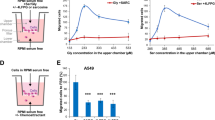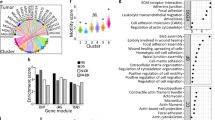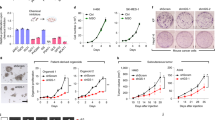Abstract
Oncogenic transformation involves reprogramming of cell metabolism, whereby steady-state levels of intracellular NAD+ and NADH can undergo dramatic changes while ATP concentration is generally well maintained. Altered expression of nicotinamide phosphoribosyltransferase (NAMPT), the rate-limiting enzyme of NAD+-salvage, accompanies the changes in NAD(H) during tumorigenesis. Here, we show by genetic and pharmacological inhibition of NAMPT in glioma cells that fluctuation in intracellular [NAD(H)] differentially affects cell growth and morphodynamics, with motility/invasion capacity showing the highest sensitivity to [NAD(H)] decrease. Extracellular supplementation of NAD+ or re-expression of NAMPT abolished the effects. The effects of NAD(H) decrease on cell motility appeared parallel coupled with diminished pyruvate-lactate conversion by lactate dehydrogenase (LDH) and with changes in intracellular and extracellular pH. The addition of lactic acid rescued and knockdown of LDH-A replicated the effects of [NAD(H)] on motility. Combined, our observations demonstrate that [NAD(H)] is an important metabolic component of cancer cell motility. Nutrient or drug-mediated modulation of NAD(H) levels may therefore represent a new option for blocking the invasive behavior of tumors.









Similar content being viewed by others
References
Hanahan D, Weinberg RA (2011) Hallmarks of cancer: the next generation. Cell 144(5):646–674. doi:10.1016/j.cell.2011.02.013
Friedl P, Alexander S (2011) Cancer invasion and the microenvironment: plasticity and reciprocity. Cell 147(5):992–1009
Vander Heiden MG, Cantley LC, Thompson CB (2009) Understanding the Warburg effect: the metabolic requirements of cell proliferation. Science 324(5930):1029–1033
Warburg O (1956) On the origin of cancer cells. Science 123(3191):309–314
Deberardinis RJ, Sayed N, Ditsworth D, Thompson CB (2008) Brick by brick: metabolism and tumor cell growth. Curr Opin Genet Dev 18(1):54–61. doi:10.1016/j.gde.2008.02.003
de Figueiredo LF, Gossmann TI, Ziegler M, Schuster S (2011) Pathway analysis of NAD+ metabolism. Biochem J 439(2):341–348
Koch-Nolte F, Fischer S, Haag F, Ziegler M (2011) Compartmentation of NAD+-dependent signalling. FEBS Lett 585(11):1651–1656. doi:10.1016/j.febslet.2011.03.045
de Groof AJ, Te Lindert MM, van Dommelen MM, Wu M, Willemse M, Smift AL, Winer M, Oerlemans F, Pluk H, Fransen JA, Wieringa B (2009) Increased OXPHOS activity precedes rise in glycolytic rate in H-RasV12/E1A transformed fibroblasts that develop a Warburg phenotype. Mol Cancer 8(1):54
Garten A, Petzold S, Korner A, Imai S, Kiess W (2009) Nampt: linking NAD biology, metabolism and cancer. Trends Endocrinol Metab 20(3):130–138
Nikiforov A, Dolle C, Niere M, Ziegler M (2011) Pathways and subcellular compartmentation of NAD biosynthesis in human cells: from entry of extracellular precursors to mitochondrial NAD generation. J Biol Chem 286(24):21767–21778. doi:10.1074/jbc.M110.213298
Houtkooper RH, Pirinen E, Auwerx J (2012) Sirtuins as regulators of metabolism and healthspan. Nat Rev Mol Cell Biol 13(4):225–238. doi:10.1038/nrm3293
Bowlby SC, Thomas MJ, D’Agostino RB Jr, Kridel SJ (2012) Nicotinamide phosphoribosyl transferase (Nampt) is required for de novo lipogenesis in tumor cells. PLoS ONE 7(6):e40195. doi:10.1371/journal.pone.0040195
Holen K, Saltz LB, Hollywood E, Burk K, Hanauske AR (2008) The pharmacokinetics, toxicities, and biologic effects of FK866, a nicotinamide adenine dinucleotide biosynthesis inhibitor. Investig New Drugs 26(1):45–51
Cerna D, Li H, Flaherty S, Takebe N, Coleman CN, Yoo SS (2012) Inhibition of nicotinamide phosphoribosyltransferase (NAMPT) activity by small molecule GMX1778 regulates reactive oxygen species (ROS)-mediated cytotoxicity in a p53- and nicotinic acid phosphoribosyltransferase1 (NAPRT1)-dependent manner. J Biol Chem 287(26):22408–22417. doi:10.1074/jbc.M112.357301
Zhao Y, Jin J, Hu Q, Zhou HM, Yi J, Yu Z, Xu L, Wang X, Yang Y, Loscalzo J (2011) Genetically encoded fluorescent sensors for intracellular NADH detection. Cell Metab 14(4):555–566. doi:10.1016/j.cmet.2011.09.004
Van Horssen R, Galjart N, Rens JA, Eggermont AM, ten Hagen TL (2006) Differential effects of matrix and growth factors on endothelial and fibroblast motility: application of a modified cell migration assay. J Cell Biochem 99(6):1536–1552
Murphy DA, Courtneidge SA (2011) The ‘ins’ and ‘outs’ of podosomes and invadopodia: characteristics, formation and function. Nat Rev Mol Cell Biol 12(7):413–426. doi:10.1038/nrm3141
Fantin VR, St-Pierre J, Leder P (2006) Attenuation of LDH-A expression uncovers a link between glycolysis, mitochondrial physiology, and tumor maintenance. Cancer Cell 9(6):425–434. doi:10.1016/j.ccr.2006.04.023
Le A, Cooper CR, Gouw AM, Dinavahi R, Maitra A, Deck LM, Royer RE, Vander Jagt DL, Semenza GL, Dang CV (2010) Inhibition of lactate dehydrogenase A induces oxidative stress and inhibits tumor progression. Proc Natl Acad Sci USA 107(5):2037–2042. doi:10.1073/pnas.0914433107
Tennant DA, Duran RV, Gottlieb E (2010) Targeting metabolic transformation for cancer therapy. Nat Rev Cancer 10(4):267–277
Gianni D, Diaz B, Taulet N, Fowler B, Courtneidge SA, Bokoch GM (2009) Novel p47(phox)-related organizers regulate localized NADPH oxidase 1 (Nox1) activity. Sci Signal 2(88):ra54. doi:10.1126/scisignal.2000370
Hung RJ, Pak CW, Terman JR (2011) Direct redox regulation of F-actin assembly and disassembly by Mical. Science 334(6063):1710–1713. doi:10.1126/science.1211956
Zhang Q, Wang SY, Nottke AC, Rocheleau JV, Piston DW, Goodman RH (2006) Redox sensor CtBP mediates hypoxia-induced tumor cell migration. Proc Natl Acad Sci USA 103(24):9029–9033. doi:10.1073/pnas.0603269103
Terashima M, Shimoyama M, Tsuchiya M (1999) Introduction of NAD decreases fMLP-induced actin polymerization in chicken polymorphonuclear leukocytes—the role of intracellular ADP-ribosylation of actin for cytoskeletal organization. Biochem Mol Biol Int 47(4):615–620
North BJ, Marshall BL, Borra MT, Denu JM, Verdin E (2003) The human Sir2 ortholog, SIRT2, is an NAD+-dependent tubulin deacetylase. Mol Cell 11(2):437–444
Zhang Y, Zhang M, Dong H, Yong S, Li X, Olashaw N, Kruk PA, Cheng JQ, Bai W, Chen J, Nicosia SV, Zhang X (2009) Deacetylation of cortactin by SIRT1 promotes cell migration. Oncogene 28(3):445–460
Goody MF, Kelly MW, Lessard KN, Khalil A, Henry CA (2010) Nrk2b-mediated NAD+ production regulates cell adhesion and is required for muscle morphogenesis in vivo: Nrk2b and NAD+ in muscle morphogenesis. Dev Biol 344(2):809–826. doi:10.1016/j.ydbio.2010.05.513
Quistorff B, Grunnet N (2011) The isoenzyme pattern of LDH does not play a physiological role; except perhaps during fast transitions in energy metabolism. Aging (Albany NY) 3(5):457–460
Attanasio F, Caldieri G, Giacchetti G, van Horssen R, Wieringa B, Buccione R (2011) Novel invadopodia components revealed by differential proteomic analysis. Eur J Cell Biol 90(2–3):115–127. doi:10.1016/j.ejcb.2010.05.004
Hirschhaeuser F, Sattler UG, Mueller-Klieser W (2011) Lactate: a metabolic key player in cancer. Cancer Res 71(22):6921–6925
Goetze K, Walenta S, Ksiazkiewicz M, Kunz-Schughart LA, Mueller-Klieser W (2011) Lactate enhances motility of tumor cells and inhibits monocyte migration and cytokine release. Int J Oncol 39(2):453–463. doi:10.3892/ijo.2011.1055
Colen CB, Shen Y, Ghoddoussi F, Yu P, Francis TB, Koch BJ, Monterey MD, Galloway MP, Sloan AE, Mathupala SP (2011) Metabolic targeting of lactate efflux by malignant glioma inhibits invasiveness and induces necrosis: an in vivo study. Neoplasia 13(7):620–632
Bonuccelli G, Tsirigos A, Whitaker-Menezes D, Pavlides S, Pestell RG, Chiavarina B, Frank PG, Flomenberg N, Howell A, Martinez-Outschoorn UE, Sotgia F, Lisanti MP (2010) Ketones and lactate “fuel” tumor growth and metastasis: evidence that epithelial cancer cells use oxidative mitochondrial metabolism. Cell Cycle 9(17):3506–3514
Stock C, Schwab A (2009) Protons make tumor cells move like clockwork. Pflugers Arch 458(5):981–992. doi:10.1007/s00424-009-0677-8
Frantz C, Barreiro G, Dominguez L, Chen X, Eddy R, Condeelis J, Kelly MJ, Jacobson MP, Barber DL (2008) Cofilin is a pH sensor for actin free barbed end formation: role of phosphoinositide binding. J Cell Biol 183(5):865–879. doi:10.1083/jcb.200804161
Magalhaes MA, Larson DR, Mader CC, Bravo-Cordero JJ, Gil-Henn H, Oser M, Chen X, Koleske AJ, Condeelis J (2011) Cortactin phosphorylation regulates cell invasion through a pH-dependent pathway. J Cell Biol 195(5):903–920. doi:10.1083/jcb.201103045
Busco G, Cardone RA, Greco MR, Bellizzi A, Colella M, Antelmi E, Mancini MT, Dell’Aquila ME, Casavola V, Paradiso A, Reshkin SJ (2010) NHE1 promotes invadopodial ECM proteolysis through acidification of the peri-invadopodial space. Faseb J 24(10):3903–3915. doi:10.1096/fj.09-149518
Olson MF, Sahai E (2009) The actin cytoskeleton in cancer cell motility. Clin Exp Metastasis 26(4):273–287
Van Horssen R, Janssen E, Peters W, van de Pasch L, Te Lindert MM, van Dommelen MM, Linssen PC, ten Hagen TL, Fransen JA, Wieringa B (2009) Modulation of cell motility by spatial repositioning of enzymatic ATP/ADP exchange capacity. J Biol Chem 284(3):1620–1627
Hung YP, Albeck JG, Tantama M, Yellen G (2011) Imaging cytosolic NADH-NAD(+) redox state with a genetically encoded fluorescent biosensor. Cell Metab 14(4):545–554. doi:10.1016/j.cmet.2011.08.012
Koivusalo M, Welch C, Hayashi H, Scott CC, Kim M, Alexander T, Touret N, Hahn KM, Grinstein S (2010) Amiloride inhibits macropinocytosis by lowering submembranous pH and preventing Rac1 and Cdc42 signaling. J Cell Biol 188(4):547–563. doi:10.1083/jcb.200908086
Chiarugi A, Dolle C, Felici R, Ziegler M (2012) The NAD metabolome—a key determinant of cancer cell biology. Nat Rev Cancer 12(11):741–752. doi:10.1038/nrc3340
Yin H, Veer EV, Frontini MJ, Thibert V, O’Neil C, Watson A, Szasz P, Chu MW, Pickering JG (2012) Intrinsic directionality of migrating vascular smooth muscle cells is regulated by NAD+ biosynthesis. J Cell Sci. doi:10.1242/jcs.110262
Zhou M, Zhao Y, Ding Y, Liu H, Liu Z, Fodstad O, Riker AI, Kamarajugadda S, Lu J, Owen LB, Ledoux SP, Tan M (2010) Warburg effect in chemosensitivity: targeting lactate dehydrogenase-A re-sensitizes taxol-resistant cancer cells to taxol. Mol Cancer 9:33. doi:10.1186/1476-4598-9-33
Goellner EM, Grimme B, Brown AR, Lin YC, Wang XH, Sugrue KF, Mitchell L, Trivedi RN, Tang JB, Sobol RW (2011) Overcoming temozolomide resistance in glioblastoma via dual inhibition of NAD+ biosynthesis and base excision repair. Cancer Res 71(6):2308–2317. doi:10.1158/0008-5472.can-10-3213
Ho VW, Leung K, Hsu A, Luk B, Lai J, Shen SY, Minchinton AI, Waterhouse D, Bally MB, Lin W, Nelson BH, Sly LM, Krystal G (2011) A low carbohydrate, high protein diet slows tumor growth and prevents cancer initiation. Cancer Res 71(13):4484–4493. doi:10.1158/0008-5472.can-10-3973
Menssen A, Hydbring P, Kapelle K, Vervoorts J, Diebold J, Luscher B, Larsson LG, Hermeking H (2012) The c-MYC oncoprotein, the NAMPT enzyme, the SIRT1-inhibitor DBC1, and the SIRT1 deacetylase form a positive feedback loop. Proc Natl Acad Sci USA 109(4):E187–E196. doi:10.1073/pnas.1105304109
Wang B, Hasan MK, Alvarado E, Yuan H, Wu H, Chen WY (2011) NAMPT overexpression in prostate cancer and its contribution to tumor cell survival and stress response. Oncogene 30(8):907–921. doi:10.1038/onc.2010.468
Wosikowski K, Mattern K, Schemainda I, Hasmann M, Rattel B, Loser R (2002) WK175, a novel antitumor agent, decreases the intracellular nicotinamide adenine dinucleotide concentration and induces the apoptotic cascade in human leukemia cells. Cancer Res 62(4):1057–1062
Dordick RS, Brierley GP, Garlid KD (1980) On the mechanism of A23187-induced potassium efflux in rat liver mitochondria. J Biol Chem 255(21):10299–10305
Krahling H, Mally S, Eble JA, Noel J, Schwab A, Stock C (2009) The glycocalyx maintains a cell surface pH nanoenvironment crucial for integrin-mediated migration of human melanoma cells. Pflugers Arch 458(6):1069–1083. doi:10.1007/s00424-009-0694-7
Stock C, Mueller M, Kraehling H, Mally S, Noel J, Eder C, Schwab A (2007) pH nanoenvironment at the surface of single melanoma cells. Cell Physiol Biochem 20(5):679–686
Skehan P, Storeng R, Scudiero D, Monks A, McMahon J, Vistica D, Warren JT, Bokesch H, Kenney S, Boyd MR (1990) New colorimetric cytotoxicity assay for anticancer-drug screening. J Natl Cancer Inst 82(13):1107 –1112
Acknowledgments
We thank Dr. Joost van Schalkwijk and Dr. William Leenders for providing glioma cell lines, Dr. Frank van Leeuwen for NAMPT cDNA, and Dr. Wiljan Hendriks and Dr. Ad de Groof for helpful discussions. This study was supported by Grant KUN-2005-3333 from the Dutch Cancer Society (to BW), Grant Sto 654/3-2 from the Deutsche Forschungsgemeinschaft (to CS and AS), an EMBO Short Term Fellowship and a Vanderes Foundation Research Grant (number 225) (to RvH) and by grants from the Italian Association for Cancer Research (AIRC) and the European Union’s Seventh Framework Program (Grant No. 237946) (to RB).
Author information
Authors and Affiliations
Corresponding author
Electronic supplementary material
Below is the link to the electronic supplementary material.
Supplementary Movie 4 (MPG 4316 kb)
Supplementary Movie 7 (MPG 4261 kb)
Supplementary Movie 8 (MPG 4327 kb)
Supplementary Movie 9 (MPG 4320 kb)
Rights and permissions
About this article
Cite this article
van Horssen, R., Willemse, M., Haeger, A. et al. Intracellular NAD(H) levels control motility and invasion of glioma cells. Cell. Mol. Life Sci. 70, 2175–2190 (2013). https://doi.org/10.1007/s00018-012-1249-1
Received:
Revised:
Accepted:
Published:
Issue Date:
DOI: https://doi.org/10.1007/s00018-012-1249-1




